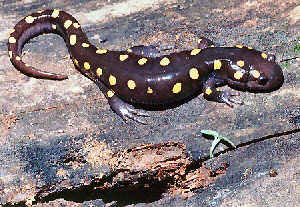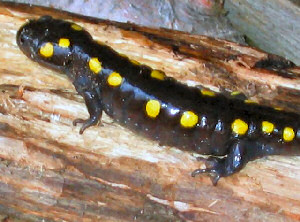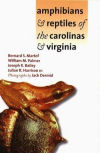
HOME
INTRO
SYMBOLS
ALMANAC
ECONOMY
GEOGRAPHY
STATE MAPS
PEOPLE
FORUM
NEWS
COOL SCHOOLS
STATE QUIZ
STATE LINKS
BOOK STORE
MARKETPLACE
GUESTBOOK
CONTACT US


Tweet
Double click on word for definition.
South Carolina State Amphibian
Woodland Heights Elementary School is located at 1216 John B. White Sr. Boulevard in Spartanburg, South Carolina. It is at this school that the successful campaign to adopt an official amphibian to represent South Carolina began. Third grade teacher, Lynn K. Burgess, and her 1997-1998 third-grade class were studying about their state when they found that South Carolina did not have an official state amphibian. They decided to do something about it.

South Carolina State Amphibian: Spotted Salamander
Photograph: © by Mike Pingleton. Used with permission.
An email and letter-writing campaign to state legislators was launched. As first unsuccessful, persistence paid off and by 1998 the campaign had made inroads. In December of 1998, bills were pre-filed in the legislature to adopt the Spotted Salamander as the official state amphibian of South Carolina.
On January 12, 1999, Representative Hawkins introduced House Bill No. 3107. This bill specified, "The Spotted Salamander, Ambystoma maculatum, is designated as the official state amphibian." Also on January 12, Representatives Littlejohn and Rhoad introduced House Bill No. 3111 specifying, "The Spotted Salamander, Ambystoma maculatum, is designated as the official state amphibian."
House Bill No. 3107 was voted down by the South Carolina House of Representatives on March 3, 1999, but House Bill No. 3111 was approved by the House of Representatives on April 21, 1999 and forwarded to the South Carolina Senate for their approval.
On June 6, 1999 House Bill No. 3111 was approved by the South Carolina Legislature. On June 11, 1999, the legislation was signed by Governor Beasley making the Spotted Salamander the official state amphibian of South Carolina.
About the Spotted Salamander

South Carolina State Amphibian: Spotted Salamander
Spotted Salamanders Ambystoma maculatum are found all over the state of South Carolina but, they are not normally seen. That's because they spend most of their adult lives in underground burrows though they may sometimes be found beneath rotting logs or leaves in mixed deciduous forests. Here they grow up to 6 to 9 1/2 inches long. If you dig under enough logs, you're sure to recognize the Spotted Salamander when you see it. From black to blue-black, dark gray or dark brown, the two rows of bright yellow or orange spots from head to tail can't be missed.
In the winter months, you may spot the elusive Spotted Salamander as it heads to a nearby pool or pond to lay eggs. They are prompted from their underground burrows by the sound of rain and warming temperatures.
Adult Spotted Salamanders eat a variety of insects, spiders, beetles, snails, slugs and earthworms.
South Carolina Law
The following information was excerpted from the South Carolina General Statutes, Title 1, Chapter 1, Article 9.
TITLE 1. Administration of the Government.
CHAPTER 1. GENERAL PROVISIONS.
ARTICLE 9. STATE EMBLEMS, PLEDGE TO STATE FLAG, OFFICIAL OBSERVANCES.
SECTION 1-1-699. Official State amphibian.
The Spotted Salamander, Ambystoma maculatum, is designated as the official state amphibian.
Sources...
"South Carolina Code of Laws." 2005. South Carolina Legislature. 12 January 2005
"AmphibiaWeb." University of California, Berkeley. 2005. 14 January 2005
USGS, Northern Prairie Wildlife Research Center. 2005. 12 January 2005
Shearer, Benjamin F. and Barbara S. State Names, Seals, Flags and Symbols: A Historical Guide Third Edition, Revised and Expanded. Westport, Conn: Greenwood Press, 3 Sub edition, 2001.
Additional Information
The State Amphibian: South Carolina State House.
South Carolina State Amphibian ? Spotted Salamander: SCIWAY - South Carolina's Information Highway.
Spotted Salamander, Ambystoma maculatum: Savannah River Ecology Laboratory.
Spotted Salamander (Ambystoma maculatum): Entry at the National Wildlife Federation.
Ambystoma maculatum: CalPhoto photographs. The Biodiversity Sciences Technology group (BSCIT), a part of the Berkeley Natural History Museums at the University of California, Berkeley..
Ambystoma maculatum (Spotted Salamander): University of Michigan Museum of Zoology: Animal Diversity Web.
Ambystoma maculatum Spotted Salamander: Encyclopedia of Life.
Ambystoma maculatum (Spotted Salamander): AmphibiaWeb, University of California, Berkeley.
Ambystoma maculatum - (Shaw, 1802): Taxonomy, conservation status, distribution, and biodiveristy information about the Spotted Salamander.
Ambystoma maculatum (Shaw, 1802): Taxonomy, references, geographic information, and commentary about the Spotted Salamander.
State amphibians: Complete list of official state amphibians from NETSTATE.COM.
More symbols & emblems: Complete list of official South Carolina state symbols from NETSTATE.COM.
Newts and Salamandersby Frank Indiviglio
Salamanders of the United States and Canada: by James W. Petranka. 587 pages. Smithsonian; 1 edition (July 17, 1998) This survey of North American salamanders is the first since the 1940s and presents the most up-to-date research on every species. Beginning with two keys to help the reader identify an animal in the hand, whether it is an adult or a larva ("tadpole"), the book then discusses each species individually.
Newts and Salamanders: Everything About Selection, Care, Nutrition, Diseases, Breeding, and Behavior by Frank Indiviglio. 96 pages. Barron's Educational Series (June 1, 1997) Terrarium enthusiasts will find up-to-date information and full-color photos describing the major native and exotic species of newts and salamanders. The author gives advice on feeding and keeping them in a healthful environment. Topics include creating the various types of habitats, nutrition, reproduction, the treatment of diseases, and sources of food and supplies.
What is an Amphibian? (The Science of Living Things) , by Bobbie Kalman and Jacqueline Langille, 32 pages, Crabtree Publishing Company (2000). Reading level: Ages 9-12. The large, full-color photographs and illustrations that pepper every page of these books will catch the eye of browsers but it is the informative, easy-to-read texts that will hold their interest.
Peterson First Guide to Reptiles and Amphibians , by Robert C. Stebbins, Joseph T. Collins and Roger Conant. Edited by Roger Tory Peterson. 128 pages, Houghton Mifflin Harcourt (April 15, 1999). From mudpuppies to rattlesnakes, this fascinating guide for young nature lovers describes the habits and habitats of these secretive and sometimes bizarre animals, and includes tips on how to catch and care for frogs, snakes, turtles, lizards, salamanders, and toads.

Amphibians & Reptiles of the Carolinas & Virginia , by Bernard S. Martof, William M. Palmer, Joseph R. Bailey and Julian R. Harrison III. 265 pages. The University of North Carolina Press (May 1, 1989) This illustrated guide to the frogs, snakes, turtles, salamanders, lizards, and other fascinating amphibians and reptiles of the Carolinas and Virginia features 196 exceptional natural-color photographs, descriptions, and distribution maps for each species. It will serve as an indispensable guide to zoologists, amateur naturalists, environmentalists, backpackers, campers, hikers, and everyone interested in the outdoors.
A Field Guide to Reptiles & Amphibians of Eastern & Central North America, by Roger Conant and Joseph T. Collins, 640 pages, Houghton Mifflin Harcourt; Fourth Edition edition (May 15, 1998). This newly designed field guides features detailed descriptions of 595 species and subspecies. The 656 full-color illustrations and 384 drawings show key details for accurate identification. More than 100 color photographs and 333 color photographs and 333 color distribution maps accompany the species descriptions.
Firefly Encyclopedia of Reptiles and Amphibians, edited by Tim Halliday and Kraig Adler, 240 pages, Firefly Books (September 7, 2002). With lush color photographs and lavishly detailed illustrations, this encyclopedia presents a striking abundance of information at a glance. Also noteworthy is the scholarly text, a comprehensive overview of these frequently studied phyla.
Reptiles & Amphibians for Dummies, by Patricia Bartlett, 360 pages, For Dummies; 1st edition (June 1, 2003) This essential guide tells you what you must know before you own a reptile or amphibian, with authoritative advice on everything from proper caging and feeding to health care, socializing, transporting, and more. You'll find out about the different species, normal and abnormal behavior, the basics of breeding, and complying with laws.

